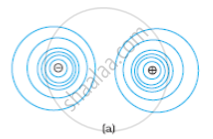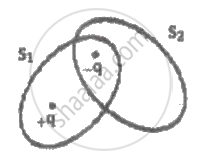Advertisements
Advertisements
Question
Depict the equipotential surface due to
(i) an electric dipole,
(ii) two identical positive charges separated by a distance.
Solution
Equipotential surfaces for (a) a dipole and (b) two identical positive charges are shown in Figure.
Notes


Some equipotential surfaces for (a) a dipole, (b) two identical positive charges.
APPEARS IN
RELATED QUESTIONS
Draw a sketch of equipotential surfaces due to a single charge (-q), depicting the electric field lines due to the charge
Why is there no work done in moving a charge from one point to another on an equipotential surface?
Depict the equipotential surfaces for a system of two identical positive point charges placed a distance(d) apart?
Answer the following question.
Write two important characteristics of equipotential surfaces.
Statement - 1: For practical purpose, the earth is used as a reference at zero potential in electrical circuits.
Statement - 2: The electrical potential of a sphere of radius R with charge Q uniformly distributed on the surface is given by `Q/(4piepsilon_0R)`.
S1 and S2 are the two imaginary surfaces enclosing the charges +q and -q as shown. The electric flux through S1 and S2 are respectively ______.

Can two equipotential surfaces intersect each other?
The work done to move a charge along an equipotential from A to B ______.
- cannot be defined as `- int_A^B E.dl`
- must be defined as `- int_A^B E.dl`
- is zero.
- can have a non-zero value.
